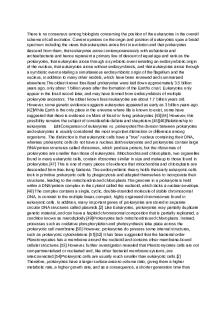Lecture 5 PDF

| Title | Lecture 5 |
|---|---|
| Author | Georgia Irving |
| Course | Personality and Health Psychology |
| Institution | Northumbria University |
| Pages | 2 |
| File Size | 208.2 KB |
| File Type | |
| Total Downloads | 44 |
| Total Views | 129 |
Summary
Lecture for the module that helped me...
Description
Personality Psychology Lecture 5: Dispositional Approach/ Trait Trait theories of Personality Aims to identify the major components of personality that influence behaviour can be through tests, psychometrics and statistical techniques e.g. factor analysis. What are traits/ dispositions? 1) Descriptive statements about personality- core characteristics. 2) The relatively stable and enduring qualities of a person. Assumed to be durable so that behaviour will be the same whatever the time or situation. 3) Difference between individuals arise from differences in the strength, amount and number of dispositions each person has. 4) Dispositions typically look at how we differ. But don’t usually explain these differences- why the differences exist and where they’ve come from. 5) We can’t actually observe them, instead we infer traits from behaviour. Goals of the dispositional strategy- identify the underlying dimensions of personality. Main traits, and number of them, will help to do this. To discover how people differ. How can we measure the differences in traits using personality tests? Type theory of personality= discrete categories view of personality. Galen’s type theory – 4 main types of personality (look at past notes) Personality type tests are useful to make a quick summary but how valid is it to think of person as a type. Is a person always one type rathe than another. Can out judgement be at fault? A major complaint about type theries is tht human personality is so varied it wont fit into a few discrete catergories. Most people are a mixture of types, not one or the other, and can’t be asigned to a discrete catergory. Traits- the theory that recognises and answers this is the trait appraoch. The continuum approach to personality e.g. height, friendliness. Gordon Allport (1897-1967) aimed to identify the key traits of personality. He looked through a english dictionanary and found 18,000 human traits. Some physical (tall), behavioural (shy) and moral (honest). Found 4,500 main personality traits. Ended up with 160 personality descriptive words. Must know 160 words to fully describe someone. Allport divided traits into 2 different groups. 1) Common Traits- shared by memebers of a culture or nature e.g. chooses a breed of dog. 2) Individual traits- a person’s unique qualities. Allport also said these individual traits take 3 forms: 1) Cardinal traits- a dominant,powerful trait that characterises and influences nearly all of a person’s behaviour. Rare. 2) Central traits- core behavioural tendencies that are highly charcteristic of an individual. It is influential but don’t dominate behaviour. We each have 5-1- central traits. 3) Secondary traits- all other traits in a person. Must know someone really well to know their secondary traits.
Personality Psychology Cattell and Eysenck Both developed their theories based on information about personality such as from questionnaires. They used a statistical technique called factor analysis to help them determine the number of traits and the important ones Factor analysis – mathematical technique, based on correlations that allows you to investigate and determine which particular items tend to be answered in the same way by a particular person. This allows you to infer what things go together. Different methods of factor analysis: Raymond Cattell- He distinguished between 2 types of traits: 1) Surface Traits- visible aspects of personality. Did factor analysis 2) Source Traits- the underlying personality traits from which surface traits are derived. He said they are 16 source traits you must know to predict someone’s personality. Data collected about personality gather from 3 sources: L Data- Life records, Q Data- questionnaire and interview data and T Data- from objective testing. The 3 types of data used gave a very systematic approach.
Hans Eysenck- His theory was based on 3 principal trait types: 1) Introversion/ extraversion 2) Stable/ unstable (Neuroticism) 3) Psychoticism (self-control) – social/ antisocial
THE COMBINATION RESULTS IN A VARIETY OF PERSONALITY CHARACTERISTICS...
Similar Free PDFs

5 - Lecture notes 5
- 4 Pages

Lecture 5
- 26 Pages

Lecture 5
- 2 Pages

Lecture 5
- 3 Pages

Lecture 5
- 2 Pages

Lecture 5
- 8 Pages

Lecture 5
- 3 Pages

Lesson 5 - Lecture notes 5
- 22 Pages

5 Statehood - Lecture notes 5
- 4 Pages

Prokaryotes 5 - Lecture notes 5
- 2 Pages

5. Conduct - Lecture notes 5
- 4 Pages

Chapter 5 - Lecture notes 5
- 15 Pages

Chapter-5 - Lecture notes 5
- 6 Pages

Chapter 5 - Lecture notes 5
- 83 Pages

Tutorial 5 - Lecture notes 5
- 3 Pages

Chapter 5 - Lecture notes 5
- 4 Pages
Popular Institutions
- Tinajero National High School - Annex
- Politeknik Caltex Riau
- Yokohama City University
- SGT University
- University of Al-Qadisiyah
- Divine Word College of Vigan
- Techniek College Rotterdam
- Universidade de Santiago
- Universiti Teknologi MARA Cawangan Johor Kampus Pasir Gudang
- Poltekkes Kemenkes Yogyakarta
- Baguio City National High School
- Colegio san marcos
- preparatoria uno
- Centro de Bachillerato Tecnológico Industrial y de Servicios No. 107
- Dalian Maritime University
- Quang Trung Secondary School
- Colegio Tecnológico en Informática
- Corporación Regional de Educación Superior
- Grupo CEDVA
- Dar Al Uloom University
- Centro de Estudios Preuniversitarios de la Universidad Nacional de Ingeniería
- 上智大学
- Aakash International School, Nuna Majara
- San Felipe Neri Catholic School
- Kang Chiao International School - New Taipei City
- Misamis Occidental National High School
- Institución Educativa Escuela Normal Juan Ladrilleros
- Kolehiyo ng Pantukan
- Batanes State College
- Instituto Continental
- Sekolah Menengah Kejuruan Kesehatan Kaltara (Tarakan)
- Colegio de La Inmaculada Concepcion - Cebu